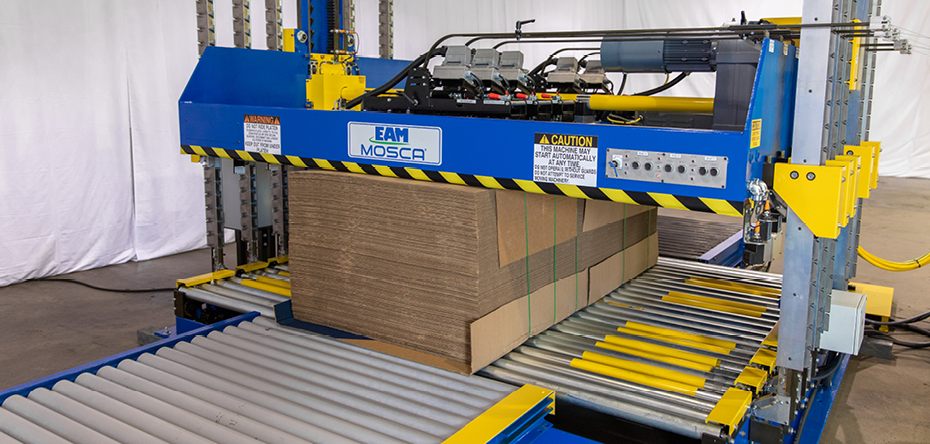12 Steps to Choosing the Right Compression Unitizer
Unitization of corrugated box and sheet loads is a process step through which all production must pass in order to be shipped to the customer. Its essential nature combined with the variation in requirements based on plant size, production speed, and product mix makes a structured system selection process a wise move. The evaluation steps included here can give the prospective unitizer buyer some assurance that the system and supplier selected are the right ones for their operation.
1. Know your throughput requirements
Comparing average and peak throughput requirements, in units per hour, to unitizer capacity is an essential step. Manufacturers can provide a maximum speed for their various equipment models, with specific numbers based on whether products are strapped in one direction, cross strapped, and/or on pallets requiring strapping through a pallet void. Comparing requirements to capability will indicate whether a single unitizer with an internal turntable will do the job or if a tandem system with a turntable in-between is needed.
2. Review product and unit load size ranges
Unitizers vary in the unit width and height ranges that they can accept. Some offer extra wide and tall models. Be sure the product you select matches the products you expect to make.
3. Compare unit lengths to unitizer zone length
Unitizer internal conveyor lengths vary by manufacturer and model. Short zone length for smaller units maximizes throughput by minimizing conveying time. But long units overhanging the strapper conveyor delay entry of the next unit into the strapper area, reducing throughput. Conversely, long zones for short loads mean more conveying time and a slower production rate.
4. Match the number of heads and their spacing to your product mix
Running long sheet loads may demand the longest possible spacing between the first and last strapping heads. At the other extreme, units built from small box bundles are better served by multiple heads on close centers. Different manufacturers offer a variety of solutions with the number of head possibilities ranging from 2 to 5, with different individual spacing and overall spans. While all systems can place straps on any spacing with multiple press strokes, strapping units in a single hit maximizes throughput while providing the most stable, neatest finished units, especially on units built from small boxes. Compare your needs to the choices before deciding.
5. Check the strapping head
The strapping head is the heart of the system. Be sure to understand issues around access for clearing, cleaning, and removal. Direct drives are cleaner, quieter, and longer-lived than mechanical systems. Review the tradeoffs between weight and ruggedness. There are three strap sealing technologies used: hot blade seals, friction, and ultrasonic. All seal the straps satisfactorily. Heat seals give off smoke which can be offensive to operators with polyester strap. Friction has a lot of mechanical components and creates dust during the sealing process. Ultra-sonics is mechanically simple, smokeless, dustless, and, in the case of EAM-Mosca’s Sonixs system, has a component life in excess of 5 million cycles. Click here to find out more.
6. Be sure the compression system will work for you
Most presses sold today are electrically driven. Electric drives are the cleanest, most efficient, and have the longest stroke range compared to pneumatic or hydraulic drives. Investigate the ruggedness of the drive. It is also a good idea to ask about how manufacturers control the press on re-hits. EAM-Mosca stops the platen at the same height on multi-stroke units. Others guess at a reduced compression level and hope that the unit comes out square.
7. Review platen lockout systems
Be sure to compare the platen lock-out capability for integrity and ease of use.
8. Data collection and management
Depending on your operation’s use of data in optimizing processes, ensure there is a match between what’s offered and what you want.
9. Technical support
Unitizing systems can shut plants down. Supplier technical support, available when needed, is essential. Field service for installation and ongoing service, 24 hour emergency service via phone with the ability to plug into the system program through the internet, for both diagnosis and problem solving, are essential and should be validated. Availability of preventive and/or predictive maintenance programs demonstrates a commitment to ongoing support. Recommended service intervals can be an indicator of system reliability and longevity.
10. Strapping
These days virtually all corrugated unitizing is done with Polyester (PET) strapping. 9mm (3/8”) strap has become the dominant strap for box plants. Some sheet feeders prefer the security of a heavier 11mm or 12mm (7/16” or 1/2”) strap. PET has the recovery to keep units tight while stabilizing expanding loads. Most manufacturers make it from recycled resins, enhancing sustainability. Get advice from possible suppliers to choose the best performing, most economical strap for your operation.
11. References
When in doubt, check references. Since controls are typically integrated between the strapper supplier and material handling system vendor, talking to your conveyor supplier is a helpful check. Or, contact other plants in your company or industry organization to get real-world feedback on the system performance and support others have received from possible suppliers.
12. Don’t settle
Not all corrugated plants are the same and neither are all unitizer systems. Finding the system that fits your operation, rather than settling for someone’s standard solution, can make all the difference.
Finally, know and have confidence in the supplier you are dealing with. When you want advice or assistance, you need to be able to call people who get results and a company that puts customer performance first.
Need assistance with any of the issues raised here? Chat to us online by clicking the speech bubble icon in the bottom right corner, and we’ll be happy to answer your questions.


